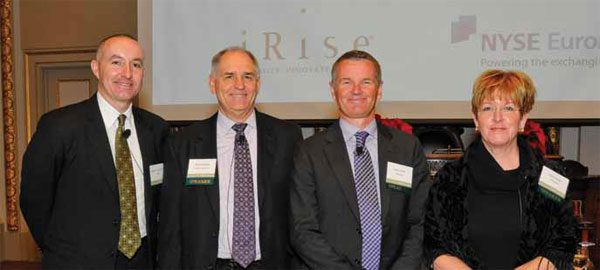Aligning People with Business Strategy
March 20 2012 by Jennifer Pellet And C.J Prince

Dick Flanagan, Emmet Keefe, Lars Bjork, Christine Jacobs
Dick Finnegan
CEO, C-Suite Analytics
Founder and President, The Retention Institute
“How important is retaining and engaging your teams? On a one-to-ten scale most of you would probably say ten. But while managers are held really accountable for [sales or revenue] metrics, they’re not held so accountable for retention and engagement. Yet 70 percent of how engaged your people are and whether or not they stay is about their boss— not about HR or employee programs. If you want to change your company to make retention and engagement metrics important, to drive them down to the first-line supervisor level, enforce them with reports that have names and tie outcomes to bonuses. Convert turnover percentages and engagement scores to the language we all know—dollars— so that now they’re really meaningful in your company.”
Emmet Keefe
CEO and Co-Founder, iRise
“The single biggest challenge for CEOs around alignment is how do you get business and technology people aligned and communicating and marching in this direction of automating business process and generating new things that will affect the top line? That’s huge because you have a fundamental communication problem between business and IT stakeholders; and as a CEO, if you’re going to really automate the business, drive it forward, make it more profitable, make the top line better, somehow you have to get the IT and business folks aligned.”
Lars Bjork
CEO, Qlik Tech
“What it all comes down to is you’ve got to motivate people. Why do they come to work? How can you assure yourself that they will come back to work the next day? Payment is not the No. 1 driver for young people today. It is feeling motivated, being engaged, making sure that they can contribute to the overall cause of the company, doing something that’s meaningful to them—which could well be financial success, but I don’t think that’s the sole driver.”
M. Christine Jacobs
CEO, Theragenics
“If I’d say anything based on my experience [maintaining alignment though a massive strategic shift that involved reorganizing and downsizing], it would be don’t you dare delegate this. Don’t let the HR people say, ‘I can do it for you, Chris.’ No, they can’t. You have to sit with the folks. You have to not delegate away your messaging to your people, because they are going to need you at that moment. I followed Maslow’s hierarchy of needs, and I said, I’m going to change the company; this is how I’m going to change it; and here’s how it affects you. I spent the majority of my time on the employees, because I felt these folks were the most important to the long-term success in transforming the company into a diversified medical device company.”
- Copyright © 2012 Chief Executive Group, LLC. All rights reserved.
No comments:
Post a Comment